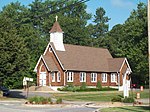Watkins Slave Cemetery
African-American cemeteriesCemeteries in MarylandHistory of slavery in MarylandTourist attractions in Anne Arundel County, Maryland
Watkins Slave Cemetery is located in Davidsonville, Maryland, in Anne Arundel County, on Maryland 424 (Davidsonville Road), 0.4 miles (0.64 km) south of US 50/301. In 1960, road construction revealed the remains of anonymous slaves. They were reburied at Mt. Tabor Church, 1421 St. Stephens Church Road, in Crownsville, Maryland. There is a historical marker, which says the slaves were associated with the Locust Grove Plantation.
Excerpt from the Wikipedia article Watkins Slave Cemetery (License: CC BY-SA 3.0, Authors).Watkins Slave Cemetery
Davidsonville Road,
Geographical coordinates (GPS) Address Nearby Places Show on map
Geographical coordinates (GPS)
| Latitude | Longitude |
|---|---|
| N 38.957194444444 ° | E -76.648722222222 ° |
Address
Davidsonville Road
Davidsonville Road
21035
Maryland, United States
Open on Google Maps








